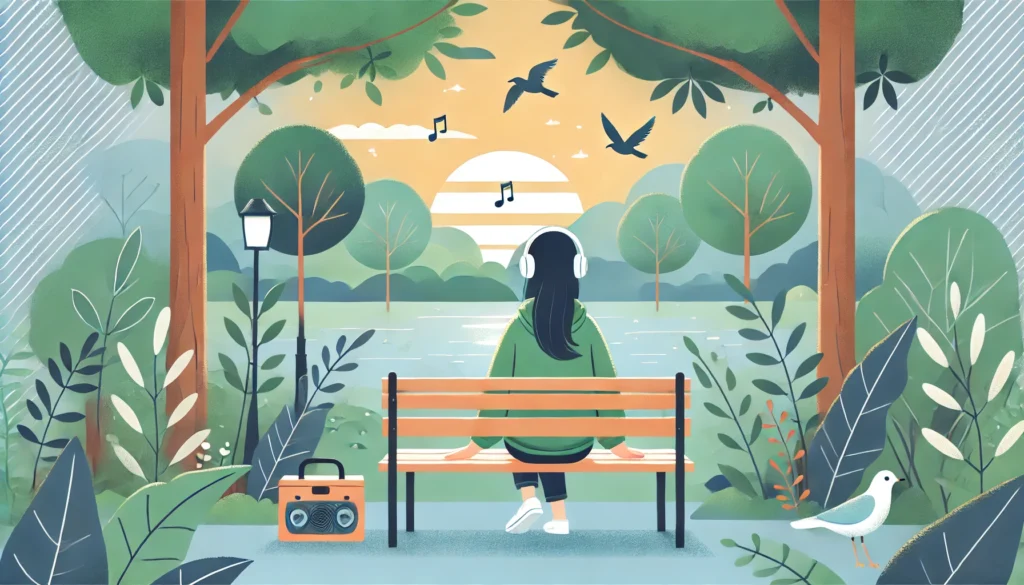Music has a profound effect on our bodies and minds. Its capacity to influence our mood, cognitive performance, and even physiological processes like heart rate and blood pressure is well documented. The science of music therapy has delved deeply into these phenomena, uncovering the mechanisms by which music can promote relaxation and well-being.
You may also like: Focus Music: Genres That Boost Concentration
The Neurological Impact of Music
Listening to music triggers the release of dopamine, a neurotransmitter associated with feelings of pleasure and reward. This neurochemical response is pivotal in the brain’s reward system, providing a natural high that can enhance our mood and emotional well-being. Moreover, dopamine release reinforces listening habits, creating a cycle of positive reinforcement.
The brain’s limbic system, which governs emotions, is activated during music listening. This activation leads to a reduction in stress and anxiety levels, as the system processes and responds to the emotional stimuli presented by music. The limbic system’s involvement highlights the deep emotional connection we share with music, making it a powerful tool for emotional regulation.
Moreover, music with a slow tempo and low pitch, often found in classical and ambient genres, can induce a meditative state by promoting alpha brainwave activity. Alpha waves are associated with relaxation and daydreaming, helping listeners to achieve a state of calmness and tranquility. This meditative state can be particularly beneficial for stress relief and mental clarity.
The Physiological Benefits
Research indicates that music can lower cortisol levels, a hormone linked to stress. Cortisol reduction is significant because chronic high levels can lead to various health issues, such as anxiety, depression, and heart disease. By lowering cortisol, music can serve as a preventive tool against these stress-related conditions.
Additionally, music can decrease heart rate and blood pressure, two critical indicators of physical stress. A slower heart rate and lower blood pressure contribute to an overall sense of calm, promoting relaxation and well-being. These physiological changes are not only beneficial for stress relief but also for improving cardiovascular health.
Music therapy is increasingly being employed in clinical settings to assist with pain management and improve patient outcomes. The calming effects of music can distract patients from pain, reduce the need for medication, and enhance recovery processes. This therapeutic application underscores the potential of music as a non-invasive treatment option for various health conditions.
Psychological and Emotional Effects
Music can evoke a wide range of emotions, from joy and excitement to sadness and nostalgia. These emotional responses can be harnessed to improve mental health, providing listeners with a safe outlet for emotional expression and processing. By engaging with music that resonates with their feelings, individuals can experience catharsis and emotional release.
Furthermore, music can enhance cognitive performance and concentration. Certain genres, such as classical and instrumental music, have been shown to improve focus and productivity, making them ideal for studying or working. This cognitive boost can be attributed to the structured patterns and rhythms in music, which stimulate brain activity and improve attention span.
Listening to music can also foster social connections and improve interpersonal relationships. Shared musical experiences, such as attending concerts or listening to playlists together, can strengthen bonds and create a sense of community. Music’s universal language transcends cultural and linguistic barriers, bringing people together through shared emotional experiences.
Historical Context of Relaxation Music
Throughout history, music has played a pivotal role in cultural and spiritual practices, often serving as a tool for relaxation and mental clarity. From ancient Greece, where music was used to heal the body and soul, to the meditative chants of Buddhist monks, the historical use of music for relaxation spans cultures and eras.
Ancient and Cultural Practices
In ancient China, the concept of “Yin and Yang” influenced music that sought to balance these opposing forces, promoting harmony and tranquility. Music was considered an essential aspect of achieving inner peace and was used in various rituals and ceremonies. Instruments like the guqin were favored for their soothing sounds, believed to align the listener’s energy with the natural world.
Similarly, the Sufis of the Islamic world used music and dance as a form of spiritual meditation, known as “Sama.” This practice involved listening to and participating in rhythmic music and movement, aiming to achieve a state of divine ecstasy and spiritual enlightenment. Sama illustrates how music transcends mere entertainment, serving as a conduit for spiritual growth and contemplation.
In ancient Greece, philosophers like Pythagoras and Plato explored the healing properties of music, viewing it as a science of harmony and balance. The Greeks used music therapeutically, believing it could align the body and soul, restore health, and bring about emotional equilibrium. This ancient understanding laid the groundwork for modern music therapy practices.
The Western Classical Tradition
The Western classical tradition offers a rich repertoire of works designed to evoke emotional and psychological responses. Compositions by artists such as Bach, Debussy, and Satie are celebrated for their calming and introspective qualities, offering timeless pieces that continue to inspire relaxation. These compositions often utilize gentle melodies, soothing harmonies, and deliberate pacing to create an atmosphere of serenity and reflection.
The Baroque period, exemplified by composers like Johann Sebastian Bach, emphasized balance and symmetry in music, reflecting the orderly nature of the universe. Bach’s compositions, with their intricate counterpoint and harmonious structures, have been praised for their ability to induce mental clarity and relaxation. This period’s focus on order and beauty mirrors the human desire for peace and tranquility.
Impressionist composers like Claude Debussy sought to capture the essence of nature and emotion through music, creating works that evoke vivid imagery and mood. Debussy’s pieces, characterized by their fluid harmonies and delicate textures, transport listeners to dreamlike landscapes, offering an escape from the chaos of daily life. This evocative quality makes Impressionist music a favorite for relaxation and introspection.
Indigenous and Folk Traditions
Indigenous and folk music traditions around the world have long utilized music for relaxation and healing. Native American tribes, for example, use music in rituals and ceremonies to connect with nature and the spiritual world. The soothing sounds of drums, flutes, and chants are believed to bring balance and harmony to the mind and spirit.
Similarly, African folk music often incorporates rhythmic drumming and melodic singing to promote community cohesion and emotional release. These musical elements create a sense of unity and collective relaxation, demonstrating music’s power to foster social connections and emotional healing.
In India, traditional ragas are used to evoke specific emotions and states of mind. Each raga is associated with a particular time of day or season, reflecting the natural rhythms of life. This intentional use of music to influence mood and mindset showcases the deep cultural understanding of music’s therapeutic potential.

Current Trends in Relaxation Music
The modern era has seen a proliferation of genres and styles aimed at promoting relaxation, from ambient and new-age music to nature sounds and binaural beats.
Ambient and New Age Music
These genres emphasize atmosphere and mood over traditional musical structure, often incorporating electronic sounds, natural soundscapes, and synthesized melodies. Artists like Brian Eno and Enya have popularized these styles, creating immersive experiences that transport listeners to tranquil realms. The ethereal quality of ambient and new-age music provides an escape from the pressures of everyday life, allowing listeners to drift into a state of peaceful contemplation.
Ambient music, pioneered by Brian Eno, focuses on creating a sonic environment that enhances the listener’s space and mood. Eno’s concept of “ambient music” as both ignorable and interesting allows it to blend seamlessly into the background or become the focal point of attention. This versatility makes ambient music ideal for relaxation, meditation, and even creative pursuits.
New-age music, often characterized by its spiritual and healing themes, draws inspiration from various cultural and mystical traditions. This genre frequently incorporates elements such as chanting, nature sounds, and world instruments to create a sense of serenity and transcendence. The soothing and uplifting qualities of new-age music have made it a popular choice for yoga, meditation, and holistic wellness practices.
Binaural Beats and Brainwave Entrainment
A more recent innovation, binaural beats involve playing slightly different frequencies in each ear to stimulate specific brainwave patterns. This technique is believed to enhance relaxation, meditation, and focus, offering a novel approach to music therapy. Binaural beats can synchronize brainwaves to desired states, such as alpha for relaxation or theta for deep meditation, providing a tailored auditory experience.
Research suggests that binaural beats can reduce anxiety and stress, improve sleep quality, and boost cognitive performance. By modulating brain activity, binaural beats offer a non-invasive way to influence mood and mental state, making them a valuable tool for relaxation and self-improvement. This growing interest in brainwave entrainment reflects a broader trend towards personalized and science-based wellness practices.
The accessibility of binaural beats through digital platforms and mobile apps has made this technology widely available to the public. Users can easily find tracks designed for various purposes, from relaxation and sleep to focus and creativity. This democratization of binaural beats allows individuals to explore and customize their auditory experiences, enhancing their overall well-being.
Nature Sounds and ASMR
The rise of ASMR (Autonomous Sensory Meridian Response) content has introduced many to the calming effects of natural sounds, such as rainfall, ocean waves, and forest ambiance. These sounds can evoke a primal sense of peace, connecting us to the natural world. ASMR is often described as a tingling sensation that begins on the scalp and moves down the body, creating a deeply relaxing and comforting experience.
Nature sounds, whether recorded or synthesized, are used to create immersive soundscapes that promote relaxation and stress relief. The rhythmic patterns and gentle tones of nature sounds mimic the natural environment, providing a sense of familiarity and comfort. This connection to nature can be especially beneficial for individuals living in urban settings, offering a respite from the noise and hustle of city life.
ASMR content, which includes a wide range of sounds and triggers, has gained popularity for its ability to induce relaxation and improve sleep. Common ASMR triggers include whispering, tapping, and crinkling, which elicit a soothing response in listeners. The personalized and intimate nature of ASMR content allows individuals to explore their preferences and discover what sounds resonate with their relaxation needs.

Curating Your Perfect Relaxation Playlist
Creating a personalized playlist can be an enriching experience, allowing you to tailor your listening experience to your preferences and needs. Here are some recommendations for great music to listen to when seeking relaxation.
Classical Compositions
- Claude Debussy’s “Clair de Lune”: A gentle and evocative piece that captures the essence of moonlight. The delicate piano melodies weave a tapestry of sound that transports listeners to a world of dreams and imagination, offering a serene escape from reality.
- Erik Satie’s “Gymnopédies”: Minimalist and tranquil, these compositions are perfect for quiet contemplation. The simplicity and elegance of Satie’s music create a sense of stillness and introspection, allowing listeners to delve deep into their thoughts and emotions.
- Johann Sebastian Bach’s “Air on the G String”: Known for its soothing melody and harmonic beauty. This piece exemplifies the balance and order of Baroque music, providing a calming and structured listening experience that promotes mental clarity and peace.
Ambient and Electronic
- Brian Eno’s “Ambient 1: Music for Airports”: An iconic album that pioneered the ambient genre. Eno’s innovative approach to sound design creates an enveloping atmosphere that enhances the listener’s environment, making it ideal for relaxation and contemplation.
- Moby’s “Long Ambients 1: Calm. Sleep.”: A collection of ambient tracks designed to aid relaxation and sleep. The extended, flowing compositions provide a gentle backdrop for meditation or rest, offering a sense of continuity and tranquility.
Nature and ASMR
- Rainforest Sounds: A compilation of serene jungle ambiance, perfect for unwinding after a long day. The rich tapestry of natural sounds immerses listeners in the lush environment of the rainforest, promoting relaxation and a connection to nature.
- Ocean Waves: The rhythmic ebb and flow of the sea can be profoundly calming. The gentle lapping of waves provides a consistent and soothing background noise, encouraging a state of relaxation and mindfulness.
Personalized Playlists and Exploration
Creating a personalized playlist allows you to explore and discover what types of music resonate with your relaxation needs. Consider incorporating a mix of genres, tempos, and styles to keep your playlist dynamic and engaging. Experiment with different combinations to find the perfect balance that suits your mood and preferences.
Consider using streaming services and music apps that offer curated playlists and recommendations based on your listening habits. These platforms can introduce you to new artists and genres, expanding your musical horizons and enhancing your relaxation experience. The convenience of digital music makes it easy to update and customize your playlist as your tastes and needs evolve.

Future Implications of Relaxation Music
As research continues to explore the therapeutic potential of music, we can expect to see further integration of relaxation music into wellness practices. Emerging technologies, such as virtual reality and AI-generated music, may offer new ways to experience and customize relaxation music, enhancing its accessibility and effectiveness.
AI and Virtual Reality in Music
AI technology is being used to compose personalized music tracks that adapt to the listener’s physiological responses, creating tailored relaxation experiences. These AI-generated compositions can respond in real-time to changes in heart rate, stress levels, and mood, offering a bespoke auditory experience that aligns with the listener’s current state.
Virtual reality environments can immerse users in calming soundscapes, enhancing the sensory experience. By combining visual and auditory stimuli, VR can create a fully immersive relaxation environment that transports users to tranquil locations, such as serene beaches or lush forests. This multisensory approach can amplify the calming effects of music, providing a deeper level of relaxation and stress relief.
Expanding Access and Inclusivity
As technology advances, the accessibility of relaxation music is likely to increase, making it available to a broader audience. Innovations in digital platforms and streaming services can facilitate access to a diverse range of music, catering to various cultural and personal preferences. This inclusivity ensures that everyone can find music that resonates with their relaxation needs.
The integration of relaxation music into public spaces and wellness initiatives can promote mental health and well-being on a larger scale. Schools, workplaces, and healthcare facilities can incorporate music therapy programs and relaxation music playlists to support mental health and stress reduction. This widespread adoption can normalize the use of music as a tool for emotional and psychological well-being.
Future Research and Applications
Ongoing research into the therapeutic potential of music will likely uncover new applications and benefits for relaxation music. Studies exploring the effects of different genres, tempos, and musical structures on mental and physical health can provide insights into the most effective relaxation techniques. This research can inform the development of targeted music therapy interventions for various conditions and populations.
As our understanding of music’s impact on the brain and body deepens, we may discover new ways to harness its power for relaxation and healing. Future innovations could include personalized music therapy programs that integrate biometric data and machine learning algorithms to optimize relaxation outcomes. This cutting-edge approach could revolutionize the way we use music for wellness and self-care.
Conclusion
In our fast-paced world, finding time to relax and unwind is more important than ever. With a deeper understanding of the science and history of relaxation music, you can create a playlist that not only soothes the mind but also nurtures the soul. So, take a moment, find your chill vibe, and let the music guide you to a place of peace and tranquility.
By exploring the rich tapestry of relaxation music, from ancient traditions to modern innovations, you can discover the transformative power of sound. Whether through classical compositions, ambient soundscapes, or nature-inspired melodies, music offers a sanctuary for the mind and soul. Embrace the journey of musical exploration and let it lead you to a state of harmony and contentment.
As you curate your personalized relaxation playlist, remember to remain open to new sounds and experiences. The world of music is vast and diverse, offering endless possibilities for relaxation and inspiration. Allow yourself to be guided by your intuition and preferences, and enjoy the process of discovering music that resonates with your inner self.
Further Reading:
Keep Your Brain Young with Music
The 63 Best Feel-Good Songs That Will Instantly Put You in a Happy Mood
Best Study Playlists – Study Music, Focus Music
Important Note: The information contained in this article is for general informational purposes only, and should not be construed as health or medical advice, nor is it intended to diagnose, prevent, treat, or cure any disease or health condition. Before embarking on any diet, fitness regimen, or program of nutritional supplementation, it is advisable to consult your healthcare professional in order to determine its safety and probable efficacy in terms of your individual state of health.
Regarding Nutritional Supplements Or Other Non-Prescription Health Products: If any nutritional supplements or other non-prescription health products are mentioned in the foregoing article, any claims or statements made about them have not been evaluated by the U.S. Food and Drug Administration, and such nutritional supplements or other health products are not intended to diagnose, treat, cure, or prevent any disease.


